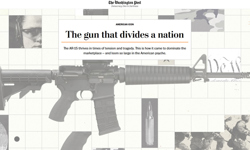| State of online development | |
| Over the course of four issues, Andrea Kirkby will review the state of online development as follows: | |
| Sep/Oct 2005 | National newspapers |
| Nov/Dec 2005 | Consumer magazines |
| Jan/Feb 2006 | Regional newspapers |
| Mar/Apr 2006 | B2B Magazines |
Consumer magazines are now online in increasing numbers. But while all the national newspapers and most of the regionals are now on the web (and on mobile), and some B2B magazines make the majority of their revenues online, consumer magazines seem to have been a little slow out of the blocks. Richard Foan at ABC Electronic says that relatively few are audited, "because it’s still early days for some of them."
That differs slightly by sector, of course. You’d expect computer magazines to be online pretty quickly, and you’d be right. "Finance, travel, technology and perhaps motoring," Bill Murray of Haymarket and the AOP says, "embraced the web early on." The more specialised subject matter areas found the transition easier, while "larger, more general publishers were slower to get on board because their background and printed offering perhaps didn’t lend itself so obviously and easily to that way of thinking." Richard Foan points out that magazines catering to games and computer buyers, "early adopters of all forms of electronic media," also had advertisers who were early adopters of internet media - something the women’s magazines, for instance, didn’t have. The perception that men are bigger computer users than women may also have had something to do with that - though it’s a perception that is increasingly at odds with reality.
Must have vs nice to have
Paid-for content hasn’t made huge gains in this sector, particularly when compared to the B2B sector. As Bill Murray points out, while B2B content is often a business expense allowable against tax, payment for consumer content comes out of the consumer’s own pocket - so there’s less propensity to spend! And while B2B content is often a must-have for the user, most consumer content is a discretionary spend - a ‘nice to have’. Even so, he says, Haymarket has had some success with paid-for content on the consumer side: "we now have 8,000 plus people paying 50 dollars a year for the full Autosport.com site. It’s very encouraging that we’re making some progress, but the commercial fears associated with experimenting in other markets make progress very slow."
Generally, the consumer has got used to ‘the internet’ - that is, web and email content - being free. However, where other online media is concerned, that’s not the case. For example, reverse billed SMS has become a major area of paid-for content, for instance with Emap’s Sneak magazine which, through mobile content player Flytxt, offers premium rate celeb gossip to its users. 3G phones will introduce more opportunities for paid-for content, including downloads and video. This looks like the best option for magazines wanting to increase content revenues online. Another intriguing option seems to be offered by Future Publishing’s deal with MSN.co.uk, for which it provides computing related content - downloads, games, hardware reviews and tutorials. MSN users don’t pay for it but presumably Microsoft does (terms of the contract have not been disclosed).
The mobile model
Guy Sneesby of Dennis Interactive likes mobile content. "Commercially, there’s a whole business model of users paying for content on the mobile phone," he says. Men’s magazine Maxim has mobile content in 21 countries, though, says Sneesby, "we don’t do this for all our brands." He’s also looking at digital TV for Maxim, but says so far TV hasn’t got a suitable business model to make it commercially viable, though the medium would fit the highly visual brand very nicely. He believes publishers need to consider both aspects when they make media choices for their brands - "What’s a good brand fit? What’s a good commercial fit?" And most importantly, he says, "Do you have a brand that deserves multiple formats?" A weak brand in print will never make a strong one online.
Creating communities
Besides different formats, one of the big issues facing consumer magazines is how to create viable user communities. Special interest magazines have often been particularly good at this, and music magazines are a case in point; for instance, Q has done well with its Glastonbury blog, which won an AOP award this year, and NME’s chat rooms and message boards have attracted a high level of traffic - 1.6m unique users in NME’s case.
Paul Brannan of News Interactive believes that "whoever’s most successful at creating online communities will be the people who survive the seismic shift in the media. It’s about people, it’s not about technology." He cites the feedback forums on eBay and Amazon.com as key features in creating stickability and trust, and Wikipedia, the cooperative online encyclopaedia, as "probably one of the best examples of an online community really achieving something" (it now has 777,739 articles in English, and is available in another forty or so languages including French, German, Russian, Tatar and Telegu). Maybe these are not conventional media, but they are competing for users’ minds and wallets, and they have discovered something which works. He believes that the media needs to take its strength from the communities for which it is created, and the web is the best way to do that - "returning to the roots of media."
Interaction
Paul Brannan points out that many communities assume that interaction is only one way - from editor to reader. But in fact, it’s two way and the savvy media owner knows how to use it both ways. He says of News Interactive, the BBC’s digital arm, "we’re a sort of umbilical cord to the audience. That’s the power of it. It’s part of the reason why our profile’s been raised around the BBC." But he believes that user generated content still needs to be mediated, except in chatrooms. "We’re going to treat any information we receive from users in the same way we do any other reporting - as there are a lot of people out there with Photoshop and a lot of imagination." That’s certainly the case for news, but it’s also vital for book and product reviews (Amazon had to change its policy on unattributed reviews after a large number of authors were found to be plugging their own works).
But he warns that "when you lift the veil on this community stuff you don’t control it any more, and there are real issues around that." The recent Cillit Bang debacle, in which a viral advertiser hijacked other peoples’ blogs to deliver its commercial message, is a case in point. Flame wars and puerile behaviour led to the closure of some media chat rooms early on - and editors may also be leery of their legal responsibility for any defamatory statements made on their forums. On the other hand, the editorial or moderating involvement can be seen as part of the media brand; "something which says, ‘This isn't coming from Kevin’s bedroom’," he jokes.
Serving the brand
Guy Sneesby also has some great user communities under his aegis, but he points out that the community has to serve the brand and the users’ passions and interests - "it’s no use just saying we need to have a blog, a chatroom, whatever. We have 16 sites, some of which have big communities and some of which have high traffic, and the two don’t always go together." For instance Evo, a real nerd site for those with an interest in classic and sports cars, has a huge community, which he calls a "passion centre", with big chatrooms - but "overall site traffic isn't huge." Its specialised nature means Evo will never be as big as AutoExpress.co.uk, "which doesn’t have such an active forum."
MaximMag.co.uk doesn’t even have a chat room. Guy Sneesby doesn’t think they’re the right format for Maxim. He says Maxim is the kind of place people come to for "killing time and having a laugh - the kind of guys who want to discuss the movie reviews are probably doing it on a movie site." He believes chat rooms and message boards work better on vertical interest sites than on general interest ones - so about half the Dennis web sites have busy forums, and the other half don’t. And he says "bolted on communities are a bad thing" - people are just chatting, not consuming content, and that doesn’t add value to the brand. On the other hand, he has been looking at video blogging as a potential development for Maxim - it would differentiate the site from other media and backs up the heavily visual, fun nature of the site.
Users now are used to searching the web for what they want. Paul Brannan says "the linear paradigm is dead" - people will not wait for a TV programme or read a magazine cover to cover. "They want what they want, and they want it now," and technology has to enable them to have that experience. So, for instance, the redesign of the NME web site - at the same time as that of the magazine - introduced more personalisation; users can create their own automated newsletters and text alerts, enabling them to control the experience (but also enabling NME to ‘push’ media out). Ben Perreau, editor of NME.com, distinguishes the online experience from the print experience - "while NME is the authority for music, NME.com is the vehicle to emotionally experience the music and give users an involvement on a community level." Print magazines which don’t have an online presence and community have an impoverished relationship with their readers, according to this view - they are weakening their brands.
Global P&L
As far as the commercial side of the business is concerned, online is making money for most consumer magazine publishers now, though it’s still heavily reliant on advertising rather than content sales. But Guy Sneesby points out that the concept of a separate online profit centre may already be outdated. He’s not afraid of the accountants - "as a department, our contribution is 33% of turnover," he says, and apart from one or two newer sites in investment mode, all the Dennis sites are now contributing - but as the market develops, it’s becoming less and less easy to attribute costs to a single profit centre. "Increasingly we’re having to look at things in the round. The cost of production, if it’s shared between different media, is difficult to split out. I feel the biggest brands will be thinking global P&L, and not online versus offline universes."
Richard Foan agrees. "Measurement needs to be about the brand, whichever channel you’re using." So ABC and ABC Electronic need to be used in a complementary way - and the areas where the two overlap, such as digital editions, are going to be most interesting in terms of formulating new methodologies (and, also, most political in terms of industry infighting). But unique users and circulation are not the same thing - so there is some complexity involved.
Multiplatform authoring
Media is no longer created for a single format, as it was in the ‘old’ media world. For Paul Brannan, repurposing is key - "there’s just a big bucket of content. Over time, channels will cease to exert the same hold over the user. So you need multiplatform authoring to dice and slice your content into multiple formats." You also need good content tagging, key to RSS and search - that’s a new media skill which some publishers have yet to learn.
According to Guy Sneesby, flexible media creation is crucial to the economies of the new media operation. "If you know at the beginning that you are shooting not just for the particular medium you’re shooting for right now, but for every other possible format, you’ll do well." It needs a different mindset not just in management but at journalist level; so, for instance, if you’re shooting video, make sure you get some decent stills too; and make sure there are some close-ups which will work on a mobile phone screen, as well as long shots which will reproduce well in print. As for moving to television, he points out, some publishers might think that’s quite an aggressive move, but a cover DVD is "television on the front of a magazine by any other name." You need original content which can be reedited for mobile, for the web, for a DVD, and potentially for TV.
New breed of competitor
What’s really interesting right now is that the old media structures are breaking down - what Paul Brannan calls a "seismic shift." Consumer magazine sites are not competing against other magazines’ websites any more; they are competing against other media - the BBC, MSN, even against Amazon.com. According to Richard Foan, ABC Electronic audits for the women’s content sector show this very clearly - "Handbag.com is obviously a massive brand in the sector and it’s not a print brand at all. Anyone who thinks print competition is all they need to worry about doesn’t understand the sector."
Handbag.com - Condé Nast’s women’s interest site - has more unique users than any other brand in its sector, with 986,695 users and 28m page views - that’s also more than the circulation of any UK women’s interest magazine. And it’s growing at 12% a year, which is better than most print circulations. (Of course, it has the advantage that you don’t have to pay for it - as does the number one print brand, Debenhams Desire, a free in-store magazine.) As Bill Murray says, "we have to recognise that we have media brands - perhaps better stated as ‘multi-media brands’. If we don’t think that way then we aren't really competing."
Indeed, as Bill notes, consumers now spend more time online than they do consuming any other medium apart from television - and that’s touch and go. "I don’t know what the figures are," he says, "but if you were a traditional media company who didn’t have a business plan that suggested the online portion of your revenues and profits was going to reflect that shift pretty clearly in the medium term, you should probably be worried." Having a website is only the first step - monetising that website and finding new models for selling content (perhaps in a personalised way, perhaps broken into microsegments, perhaps across different devices) are the key to having a business plan that moves from being defined by ink on paper to being ‘content open to all formats’.
Not everyone clearly sees the media future. But Paul Brannan says one thing is clear - "the old architecture of the media is obsolete - the walls are coming down."










